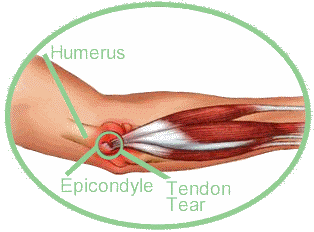The symptoms of tennis elbow:
- Pain when bending the wrist upward against a force or when stretching muscles by straightening or bending the elbow or bending the wrist downward
- Pain felt over the bony part on the outside of the elbow
- Swelling of the elbow area

Who is at risk?
- Anyone who overuses his or her forearm muscle
- It is not limited to tennis players – less than 5 percent of all tennis elbow diagnoses are related to playing tennis
- It occurs among people who do a lot of heavy lifting, typists, construction workers, baggage handlers and others
- Tennis elbow gets its name from the fact, that up to half of all frequent players develop it at some time during their careers. It is especially common among players who swing improperly, or players that overuse their forearm muscle by playing too frequently or too long.
How it develops?
Tennis elbow is a form of tendinitis caused by continued stress on the forearm muscles used in grasping and extending motions that originate in elbow.
Pain first occurs in the tendons involved in extending the wrist, such as when tennis player hits the a backhand shot. With continued stress, the muscles and tendons begin to hurt when bent or extended, or even at rest due to tiny tears that become inflamed and do not have a chance to heal.
What can you do when tennis elbow pain appears?
- Rest from the activities that cause elbow pain is the most important treatment for tennis elbow
- Apply ice to the area – for two days – 20 minutes every two hours through the day
- Place an elastic bandage around the forearm just below the elbow
- After two days of ice treatment – alternate warm compresses with ice packs to promote healing
- See the doctor if the pain persist for more than two weeks
How can you prevent tennis elbow?
- If playing tennis, use the right backhand movement
- Weight train and stretch your arms to make them stronger and more flexible – Chin ups are great exercise to strengthen your arms and upper body. Do them 3 times maximum repetitions – 3 times a week.
- Learn to pace yourself; for example, if playing tennis every day provokes the symptoms, cut back to every other day
The Pro-Relief is a revolutionary new training device designed to help people overcome their own musculoskeletal problems and pain. From the stay-at-home mom to the competitive athlete, it is instrumental in correcting muscle dysfunction which is the main cause of stress, pain and problems with movement. Active people can use the Pro-Relief to increase the benefits of their work-outs and training. The competitive or professional athlete can use it before, during and after competition to improve their performance and prevent injuries. Even the chronic problems brought on by constant overuse (repetitive motion), accidents or invasive surgery (what surgery is non-invasive?) can be eliminated with the Pro-Relief.
http://prorelief.com